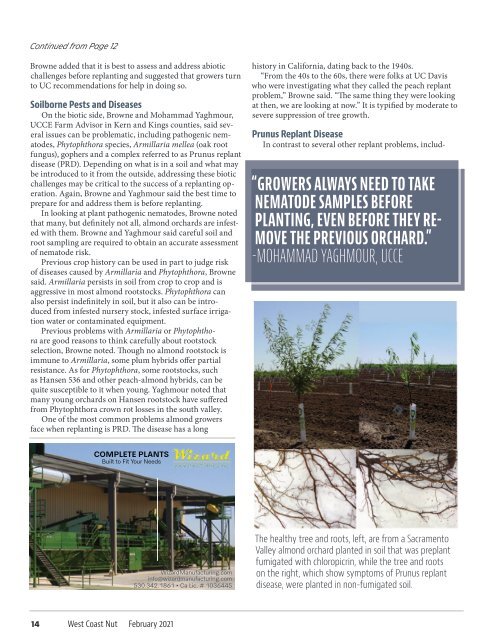Create successful ePaper yourself
Turn your PDF publications into a flip-book with our unique Google optimized e-Paper software.
Continued from Page 12<br />
Browne added that it is best to assess and address abiotic<br />
challenges before replanting and suggested that growers turn<br />
to UC recommendations for help in doing so.<br />
Soilborne Pests and Diseases<br />
On the biotic side, Browne and Mohammad Yaghmour,<br />
UCCE Farm Advisor in Kern and Kings counties, said several<br />
issues can be problematic, including pathogenic nematodes,<br />
Phytophthora species, Armillaria mellea (oak root<br />
fungus), gophers and a complex referred to as Prunus replant<br />
disease (PRD). Depending on what is in a soil and what may<br />
be introduced to it from the outside, addressing these biotic<br />
challenges may be critical to the success of a replanting operation.<br />
Again, Browne and Yaghmour said the best time to<br />
prepare for and address them is before replanting.<br />
In looking at plant pathogenic nematodes, Browne noted<br />
that many, but definitely not all, almond orchards are infested<br />
with them. Browne and Yaghmour said careful soil and<br />
root sampling are required to obtain an accurate assessment<br />
of nematode risk.<br />
Previous crop history can be used in part to judge risk<br />
of diseases caused by Armillaria and Phytophthora, Browne<br />
said. Armillaria persists in soil from crop to crop and is<br />
aggressive in most almond rootstocks. Phytophthora can<br />
also persist indefinitely in soil, but it also can be introduced<br />
from infested nursery stock, infested surface irrigation<br />
water or contaminated equipment.<br />
Previous problems with Armillaria or Phytophthora<br />
are good reasons to think carefully about rootstock<br />
selection, Browne noted. Though no almond rootstock is<br />
immune to Armillaria, some plum hybrids offer partial<br />
resistance. As for Phytophthora, some rootstocks, such<br />
as Hansen 536 and other peach-almond hybrids, can be<br />
quite susceptible to it when young. Yaghmour noted that<br />
many young orchards on Hansen rootstock have suffered<br />
from Phytophthora crown rot losses in the south valley.<br />
One of the most common problems almond growers<br />
face when replanting is PRD. The disease has a long<br />
history in California, dating back to the 1940s.<br />
“From the 40s to the 60s, there were folks at UC Davis<br />
who were investigating what they called the peach replant<br />
problem,” Browne said. “The same thing they were looking<br />
at then, we are looking at now.” It is typified by moderate to<br />
severe suppression of tree growth.<br />
Prunus Replant Disease<br />
In contrast to several other replant problems, includ-<br />
“GROWERS ALWAYS NEED TO TAKE<br />
NEMATODE SAMPLES BEFORE<br />
PLANTING, EVEN BEFORE THEY RE-<br />
MOVE THE PREVIOUS ORCHARD.”<br />
-MOHAMMAD YAGHMOUR, UCCE<br />
COMPLETE PLANTS<br />
Built to Fit Your Needs<br />
WizardManufacturing.com<br />
info@wizardmanufacturing.com<br />
530.342.1861 • Ca Lic. # 1036445<br />
The healthy tree and roots, left, are from a Sacramento<br />
Valley almond orchard planted in soil that was preplant<br />
fumigated with chloropicrin, while the tree and roots<br />
on the right, which show symptoms of Prunus replant<br />
disease, were planted in non-fumigated soil.<br />
14 West Coast Nut <strong>Feb</strong>ruary <strong>2021</strong>


















